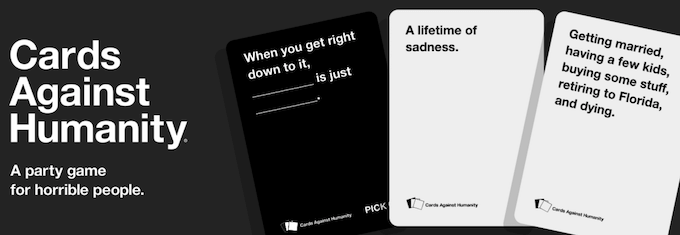Target audience: 18+
Name of the game: Cards against humanity
Game’s creator: Max Temkin, Josh Dillon, Daniel Dranove, Eli Halpern, Ben Hantoot, David Munk, David Pinsof, and Eliot Weinstein
Platform of the game: Card Game
Our game, Pitch Perfect, presents a number of interesting similarities to cards against humanity, yet the differences in mechanics make the gameplay fundamentally different. Namely, both silly party games designed to provoke laughter and encourage social interaction, yet they diverge significantly in their mechanics, rules, and win conditions. Both games rely on a degree of creativity and humor from their players, but they cater to somewhat different gaming experiences.
Mechanics
Cards Against Humanity is a game where players fill in sentence blanks with humorous or outrageous phrases from cards in their hand. The game is simple: one player, the “Card Czar,” reads a question or a fill-in-the-blank prompt from a black card. The other players select the funniest, most appropriate, or deliberately inappropriate response from their hand of white cards. The Card Czar shuffles these responses, reads them out loud, and picks the one they find most amusing. The player who submitted the winning card earns a point. For example, when I played it with a team, one winning pair was “Make … Great Again.”, where “Penises” was the winning response card.
In contrast, “Pitch Perfect” requires players to act as entrepreneurs and VCs. Each round, one player assumes the role of a VC while the others draw from a deck containing real or bluff business ideas. Entrepreneurs must then pitch these ideas, aiming to convince the VC of their viability. The key here is that the cards that entrepreneurs can draw are both real companies and really silly ideas. For instance, one of the cards that we drew when we were playing is “BoobyPack” – a real company that sells fanny pack-like storage to store in a stylish sports bra. The VC needs to discern which ideas are genuine and which are bluffs, making investment decisions based on these judgments. Players score points based on successful investments or successful bluffs, introducing elements of strategy and deduction that are not present in Cards against humanity.
Rules
The rules of Cards against humanity are straightforward, centering around the humor and shock value of the card combinations. Little strategy is involved; the game focuses on humor and group dynamics. It progresses cyclically with the role of Card Czar rotating among players, ensuring that everyone has a chance to influence the outcome of each round based on their sense of humor.
“Pitch Perfect,” however, incorporates more complex rules that involve both performance and strategy. Entrepreneurs need to be creative and persuasive, regardless of whether their card presents a real company or a bluff. The VC must use judgment and observational skills to decide which entrepreneurs are bluffing. And, of course, a HUGE part of the game is about making your pitch as funny and silly as possible while making it still sound legit. This makes things a lot more strategic, and also emphasizes a creative and delivery aspect which is not emphasized in cards against humanity.
Win Conditions/Outcomes
Cards against humanity continues until the players decide to stop; at this point, the player with the most points is typically declared the winner. The game doesn’t have a formal endpoint, which suits its casual, social nature. When I played with my group, for instance, we kind of just played until we decided to stop – after a certain point, we said “last round, last round.”
On the other hand, “Pitch Perfect” has a defined end. Each player takes a turn being the VC once, and after every player has had this role, the game concludes. Points are tallied based on successful investments and convincing pitches, with the highest scorer declared the winner. This structured approach to gameplay introduces a competitive edge that rewards both strategic thinking and persuasive skills.
Despite the difference though, the outcome is pretty much the same – someone, with the most points, wins the game.
Player Interaction and Engagement
Cards against humanity primarily engages players through reactions to surprising or comically inappropriate combinations of cards. The engagement is more about reaction than interaction, with the social experience driven by shared humor.
“Pitch Perfect” demands a higher level of player engagement. Not only must players think creatively to pitch their ideas, but they must also read the room, adjust their strategies based on the VC’s reactions, and discern the truthfulness of other players’ pitches. This makes “Pitch Perfect” a more active game, requiring continuous involvement and personal input in every round.



